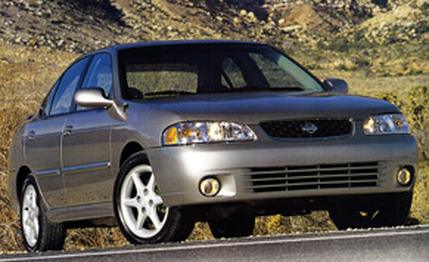
 First Drive Review
First Drive Review
Nissan says that in addition to creating a sense of solidity and substance, a key design objective for the new Sentra was avoiding flashy "look at me" styling.
Judging by our initial encounter with the first small car to come from California-based Nissan Design International, we'd say director Jerry Hirshberg's bunch nailed it. The new Sentra stands out exactly as much as Fielding Mellish at an assembly of nerds. It blends into the small-car landscape as though it's been around for years rather than just a couple of months.
Despite the déjà vu, the new Sentra is indeed new--new body shell, new automatic transmission, and new standard engine. The chassis dimensions are all but unchanged--the wheelbase, for example, remains at 99.8 inches--but the platform (HS) belongs to a new global family that supports other Nissans in other markets. Platform sharing is far from new, but it's the first time Nissan has created one of these structural chameleons.
Although the wheelbase is the same, the new Sentra is 6.5 inches longer, 1.0 inch taller, and the better part of an inch (0.7) wider. The addition of a third crossmember to the floorpan yields a 30 percent improvement in torsional rigidity over the previous car, according to Hiroatsu Hirata, chief of Nissan's product planning department, and a third motor mount reduces engine vibes. Hirata also expects that stronger roof sides, B-pillars, and outer body sills--as well as the availability of front side airbags--will yield better occupant-protection ratings in crash testing.
That's a yield no one really wants to test, of course. A more positive benefit of the new structure, with its increased dimensions, is a substantial upgrade in interior volume, particularly in the rear-seat area, which has been expanded by some two cubic feet. That may not sound like much, but it's enough to swell the Sentra beyond the EPA's compact border, putting it on a more competitive footing with the Honda Civic, Toyota Corolla, DaimlerChrysler Neons, and others.
More significant in the realm of competitive parity, at least in our minds, is the Sentra's much-enhanced standard power, thanks to a new 1.8-liter DOHC 16-valve four. Like the previous 1.6-liter DOHC 16-valve four, the 1.8 is a distinctly undersquare (80.0-by-88.0-millimeter bore and stroke) design. Unlike its smaller predecessor, the new engine has variable valve timing, a timing chain (vs. the less durable belt), a coil-on-plug ignition, and more important, a bunch more punch: 126 horsepower and 129 pound-feet of torque vs. 115 hp and a wimpy 108 pound-feet. Just as important, the engine's torque peak is 2400 rpm vs. 4000 for the 1.6.
Although the bigger Sentra is heavier--more than 150 pounds in manual GXE models--Nissan expects the new engine to whack a second off 0-to-60-mph times. Based on our last test of the midrange GXE (C/D, February 1996), that should mean a thoroughly respectable mid-eight-second sprint.
There's a variation of the engine that engenders even more pride in Nissan engineering circles, one that has inspired a specific model designation--the Sentra CA. Although this model will be limited to California, where low-sulfur fuel is the rule, the letters actually stand for "clean air," commemorating the first gasoline engine to meet the California Air Resources Board Super Ultra Low-Emission Vehicle (SULEV) standards. It has no evaporative emissions whatsoever, and it does all this with little sacrifice in output--only 4 hp and 7 pound-feet.
Although the GXE is expected to account for some 70 percent of Sentra sales, we prefer the sportier SE, with its slightly more aggressive suspension tuning and extra power. The SE's propulsion is supplied by the same 2.0-liter DOHC 16-valve four that's been around for a while. A longer intake manifold, Nissan's clever variable-capacity muffler, and other minor tweaks combine to bump output from the 140 hp and 132 pound-feet of the previous incarnation to 145 hp and 136 pound-feet.